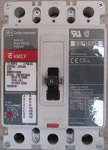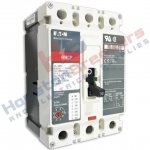You are using an out of date browser. It may not display this or other websites correctly.
You should upgrade or use an alternative browser.
You should upgrade or use an alternative browser.
Motor Circut Protector question
- Thread starter kody916
- Start date
- Status
- Not open for further replies.
kwired
Electron manager
- Location
- NE Nebraska
- Occupation
- EC
Device is rated to carry 15 or 30 amps. There is no "overload protection" but the dial selects "instantaneous trip" level. The current the motor draws for a short time when first energized and the magnetic field is building up in the motor windings can be much higher than rated running current but is very short in duration.
Device is rated to carry 15 or 30 amps.
i believe u mean continuous current rating of the device?
kwired
Electron manager
- Location
- NE Nebraska
- Occupation
- EC
Yes. It is not a circuit breaker, it is a 15 or 30 amp switch with magnetic trip but no thermal trip function. The 15 amp device only went down to 45 magnetic trip setting - but if you continuously loaded it to 30 amps it won't trip even though it is more than it is continuously rated for.Device is rated to carry 15 or 30 amps.
i believe u mean continuous current rating of the device?
- Location
- Connecticut
- Occupation
- Engineer
Yes. It is not a circuit breaker, it is a 15 or 30 amp switch with magnetic trip but no thermal trip function.
That would be a circuit breaker, by definition.
Last edited:
The previous posters are correct - those amp values are continuous current ratings. The question then is - why would I ever want to buy a breaker that's rated higher than the FLA of the motor, would that be a waste of money? The answer is no. These new high efficiency motors that are being built nowadays have higher inrush values. You can run into issues where the circuit breaker is rated properly for the FLA of the motor, but you can't adjust the inrush high enough to get the motor to start. This has happened in several instances in the plant that I work at - we replace a grounded motor with a new high efficiency one, but then the breaker keeps tripping on start-up. Then you have to replace either the whole bucket or just the breaker itself, but with the latter you can get in trouble with having to adjust the bucket lever linkage, etc. Not fun.
I believe the limit imposed by the NEC is the breaker can be rated 250% of the motor FLA as a maximum.
I believe the limit imposed by the NEC is the breaker can be rated 250% of the motor FLA as a maximum.
kwired
Electron manager
- Location
- NE Nebraska
- Occupation
- EC
:ashamed1: yep - instantaneous trip breaker, should have been more clear - is not a thermal magnetic breaker like most panelboard breakers usually are, and is for the most part only for motor applications.That would be a circuit breaker, by definition.
250% for a inverse time breaker, and if that won't let the motor start there is allowances to go higher. Instantaneous trip breakers can be 800% or 1100% for design B motors.The previous posters are correct - those amp values are continuous current ratings. The question then is - why would I ever want to buy a breaker that's rated higher than the FLA of the motor, would that be a waste of money? The answer is no. These new high efficiency motors that are being built nowadays have higher inrush values. You can run into issues where the circuit breaker is rated properly for the FLA of the motor, but you can't adjust the inrush high enough to get the motor to start. This has happened in several instances in the plant that I work at - we replace a grounded motor with a new high efficiency one, but then the breaker keeps tripping on start-up. Then you have to replace either the whole bucket or just the breaker itself, but with the latter you can get in trouble with having to adjust the bucket lever linkage, etc. Not fun.
I believe the limit imposed by the NEC is the breaker can be rated 250% of the motor FLA as a maximum.
- Location
- San Francisco Bay Area, CA, USA
- Occupation
- Electrical Engineer
If you are looking at a mag trip setting of 120A, that will correspond to a motor FLC of between 11A (1100% trip) and 15A (800% trip) for a normal motor, maybe as low as 7A (1700% trip) if it is an energy efficient motor. If you have a motor with an FLC of 15A, you can’t use the 15A continuous rated breaker because the disconnect device must be rated for a minimum of 115% of the motor FLC. So you would use the one rated for 30A (between those two choices). But if you have a motor with an FLC of 7-11A, the 30A breaker may cost you a little more.
It’s teally all a moot point though. You cannot select the size of an MCP in the field, they can ONLY be used as part of a factory built, tested and listed combination starter assembly. So in reality, those decisions were made for you before you even bought the starter. The only thing that you can do in the field is decide on the settings and in general, the starter mfr will have selected the components that offer the widest range of adjustment possible.
It’s teally all a moot point though. You cannot select the size of an MCP in the field, they can ONLY be used as part of a factory built, tested and listed combination starter assembly. So in reality, those decisions were made for you before you even bought the starter. The only thing that you can do in the field is decide on the settings and in general, the starter mfr will have selected the components that offer the widest range of adjustment possible.
- Status
- Not open for further replies.



